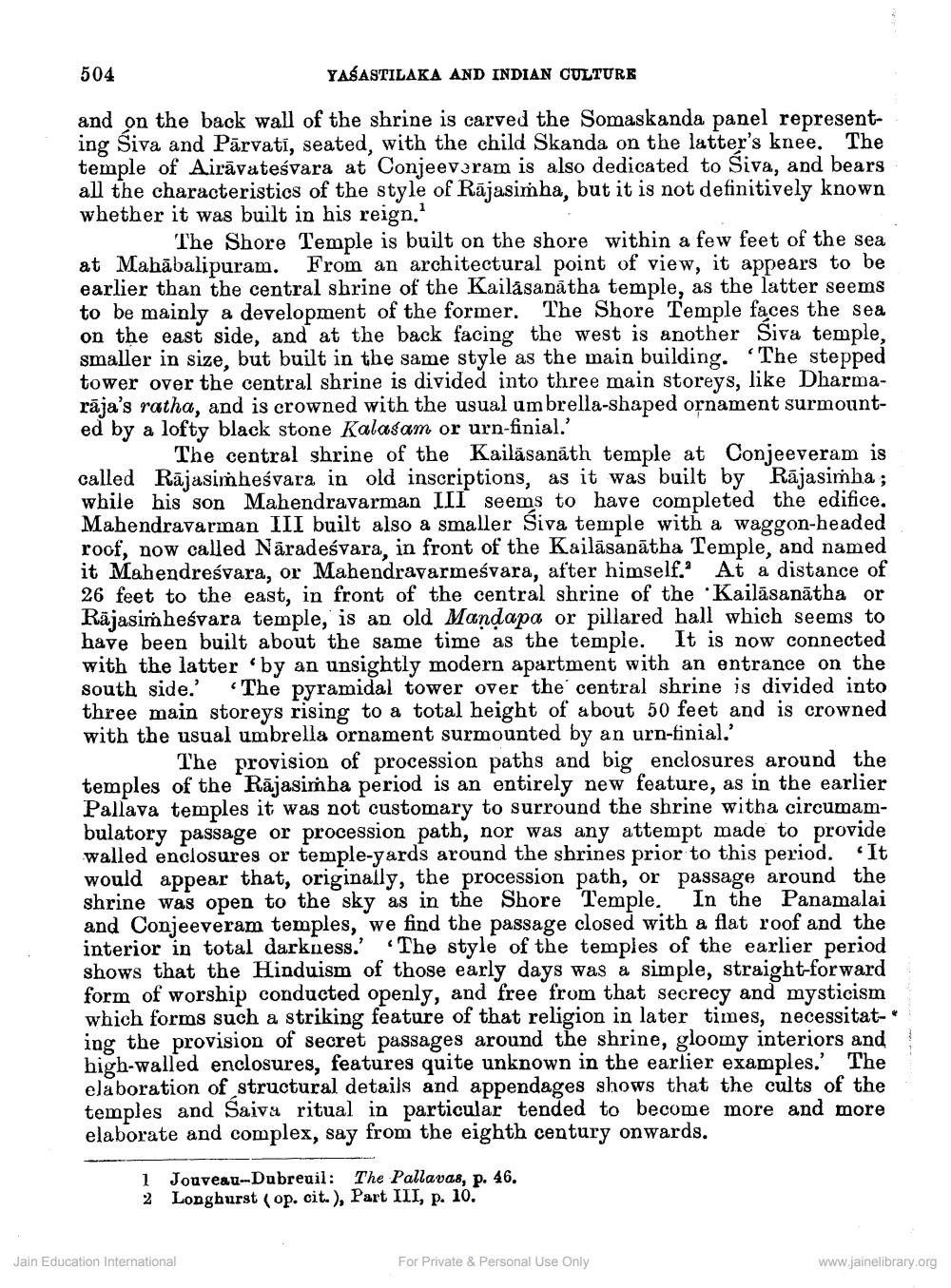________________
504
YASASTILAKA AND INDIAN CULTURE
and on the back wall of the shrine is carved the Somaskanda panel representing Siva and Parvati, seated, with the child Skanda on the latter's knee. The temple of Airavatesvara at Conjeeveram is also dedicated to Siva, and bears all the characteristics of the style of Rajasimha, but it is not definitively known whether it was built in his reign.1
The Shore Temple is built on the shore within a few feet of the sea at Mahabalipuram. From an architectural point of view, it appears to be earlier than the central shrine of the Kailasanatha temple, as the latter seems to be mainly a development of the former. The Shore Temple faces the sea on the east side, and at the back facing the west is another Siva temple, smaller in size, but built in the same style as the main building. The stepped tower over the central shrine is divided into three main storeys, like Dharmaraja's ratha, and is crowned with the usual umbrella-shaped ornament surmounted by a lofty black stone Kalasam or urn-finial.'
The central shrine of the Kailasanath temple at Conjeeveram is called Rajasimheśvara in old inscriptions, as it was built by Rajasimha; while his son Mahendravarman III seems to have completed the edifice. Mahendravarman III built also a smaller Siva temple with a waggon-headed roof, now called Naradeśvara, in front of the Kailasanatha Temple, and named it Mahendreśvara, or Mahendravarmeśvara, after himself." At a distance of 26 feet to the east, in front of the central shrine of the Kailasanatha or Rajasimheśvara temple, is an old Mandapa or pillared hall which seems to have been built about the same time as the temple. It is now connected with the latter by an unsightly modern apartment with an entrance on the south side.' The pyramidal tower over the central shrine is divided into three main storeys rising to a total height of about 50 feet and is crowned with the usual umbrella ornament surmounted by an urn-finial.'
The provision of procession paths and big enclosures around the temples of the Rajasimha period is an entirely new feature, as in the earlier Pallava temples it was not customary to surround the shrine witha circumambulatory passage or procession path, nor was any attempt made to provide walled enclosures or temple-yards around the shrines prior to this period. 'It would appear that, originally, the procession path, or passage around the shrine was open to the sky as in the Shore Temple. In the Panamalai and Conjeeveram temples, we find the passage closed with a flat roof and the interior in total darkness.' The style of the temples of the earlier period shows that the Hinduism of those early days was a simple, straight-forward form of worship conducted openly, and free from that secrecy and mysticism which forms such a striking feature of that religion in later times, necessitat- " ing the provision of secret passages around the shrine, gloomy interiors and high-walled enclosures, features quite unknown in the earlier examples.' The elaboration of structural details and appendages shows that the cults of the temples and Saiva ritual in particular tended to become more and more elaborate and complex, say from the eighth century onwards.
1 Jouveau-Dubreuil: The Pallavas, p. 46.
2 Longhurst (op. cit.), Part III, p. 10.
Jain Education International
For Private & Personal Use Only
www.jainelibrary.org




